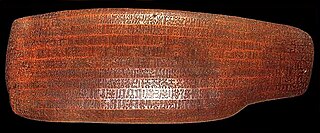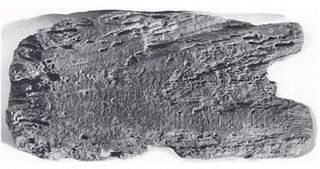| Nga‘ara | |
|---|---|
| ‘Ariki | |
| Reign | ca 1835–1859 |
| Predecessor | Kai Mako‘i |
| Successor | Kai Mako‘i ‘Iti |
| Died | 1859 |
| Issue | Kai Mako‘i ‘Iti |
| Father | Kai Mako‘i |

Nga‘ara [note 1] (reigned from the death of his father, Kai Mako‘i ca. 1835 to his own death just before 1860) was the last great ‘ariki, or paramount chief, of Easter Island, and the last master of rongorongo, the Easter Island script.
An ariki, ‘ariki, aliki, ali‘i, ari'i, aiki or hakaiki, akariki or ‘eiki (Tonga) is or was a member of a hereditary chiefly or noble rank in Polynesia.

Easter Island is a Chilean island in the southeastern Pacific Ocean, at the southeasternmost point of the Polynesian Triangle in Oceania. Easter Island is most famous for its nearly 1,000 extant monumental statues, called moai, created by the early Rapa Nui people. In 1995, UNESCO named Easter Island a World Heritage Site, with much of the island protected within Rapa Nui National Park.

Rongorongo is a system of glyphs discovered in the 19th century on Easter Island that appears to be writing or proto-writing. Numerous attempts at decipherment have been made, none successfully. Although some calendrical and what might prove to be genealogical information has been identified, none of these glyphs can actually be read. If rongorongo does prove to be writing and proves to be an independent invention, it would be one of very few independent inventions of writing in human history.
Contents
Before becoming king, Nga‘ara ran a hare rongorongo (rongorongo school) at ‘Anakena Bay. Generally fathers would teach their sons and any other boys who were interested, and Nga‘ara was the most famous teacher on the island. Boys would study three to five months to learn rongorongo.

Anakena is a white coral sand beach in Rapa Nui National Park on Rapa Nui, a Chilean island in the Pacific Ocean. Anakena has two ahus; Ahu-Ature has a single moai and Ahu Nao-Nao has seven, two of which have deteriorated. It also has a palm grove and a car park.
At the time he became ‘ariki, the real power on the island lay in the Birdman priests of ‘Orongo. One of the sacred responsibilities of the tuhunga tā (scribes and reciters of rongorongo) seems to have been the recitation or chanting of rongorongo tablets at ‘Orongo during the annual Birdman ceremonies. That quarter of the village was off limits to everyone else during the ceremonies. Nga‘ara sent students, but did not himself attend. [1]

The Tangata manu was the winner of a traditional competition on Rapa Nui. The ritual was an annual competition to collect the first sooty tern egg of the season from the islet of Motu Nui, swim back to Rapa Nui and climb the sea cliff of Rano Kau to the clifftop village of Orongo.

Orongo is a stone village and ceremonial center at the southwestern tip of Rapa Nui. It consists of a collection of low, sod-covered, windowless, round-walled buildings with even lower doors positioned on the high south-westerly tip of the large volcanic caldera called Rano Kau. Below Orongo on one side a 300-meter barren cliff face drops down to the ocean; on the other, a more-gentle but still very steep grassy slope leads down to a freshwater marsh inside the high caldera.
Rongorongo was considered to contain mana (sacred power). For example, chanting a timo (vengeance) tablet could release supernatural powers to kill a murderer. A woman would carry a pure (fertility) tablet while the scribes chanted it to increase her fertility. Tablets were used to increase crops or a catch of fish. [2] Katherine Routledge was told that one of Nga‘ara's tablets, called Kouhau ‘o te Ranga and thought to be Rongorongo text C, was one of a kind and had the power to "give conquest in war" and enslave the conquered.

Mana, in Austronesian languages, means "power", "effectiveness", and "prestige". In most cases, this power and its source are understood to be supernatural and inexplicable. Its semantics are language-dependent. The concept is significant in Polynesian culture and is part of contemporary Pacific Islander culture; it came to the attention of Western anthropologists through reports from island missionaries. Its study was included in cultural anthropology—specifically, the anthropology of religion. Links were seen between mana and earlier phases of Western religion: animism at first, followed by pre-animism.

Katherine Maria Routledge, née Pease, was an English archaeologist and anthropologist who, in 1914, initiated and carried out much of the first true survey of Easter Island.
Rongorongo is a system of glyphs discovered in the 19th century on Easter Island that appears to be writing or proto-writing. Text C of the rongorongo corpus, also known as Mamari, is one of two dozen surviving rongorongo texts. It contains the Rapa Nui calendar.
In order to take control of the island from the Birdman priests of ‘Orongo, Nga‘ara established an annual rongorongo festival at ‘Anakena. Rather than using the tablets for specific ends, it was a festival for the tablets themselves, and it became the most important assembly in pre-missionary times: [3]
The people were assembled at Anakena Bay once each year to hear all of the tablets read. The feast of the tablets was regarded as their most important fête day, and not even war was allowed to interfere with it.— Thomson (1891:514)
Hundreds attended these festivals. Heuheu staves were brought by all and stuck in the ground where the attendee stood. The tablets were recited from dawn to dusk, with a break for dinner. Nga‘ara presented the reciters with veri tapa cloths. [4] Since the mana of the tablets went through him at this festival, Nga‘ara was able to assert spiritual primacy over the island.
Tapa cloth is a barkcloth made in the islands of the Pacific Ocean, primarily in Tonga, Samoa and Fiji, but as far afield as Niue, Cook Islands, Futuna, Solomon Islands, Java, New Zealand, Vanuatu, Papua New Guinea and Hawaii. In French Polynesia it has nearly disappeared, except for some villages in the Marquesas.
When Nga‘ara died, his son Kai Mako‘i ‘Iti (Kai Mako‘i Jr) took over the festival at ‘Anakena for three years, until he was captured in the great Peruvian slaving raid of 1862. Although the slaves were freed the next year, Kai Mako‘i did not survive to return.








